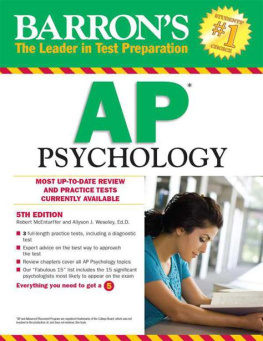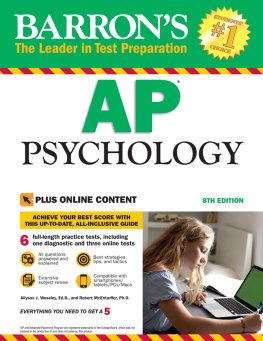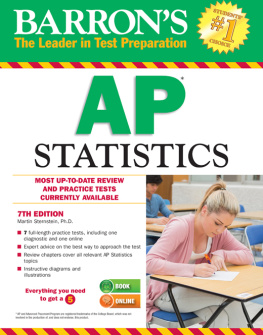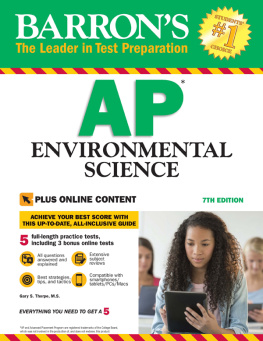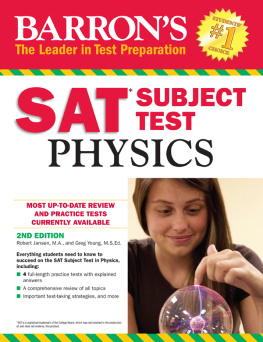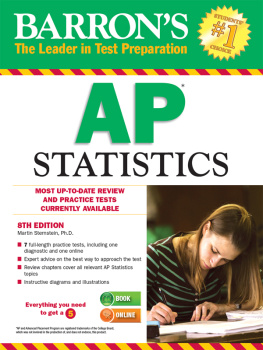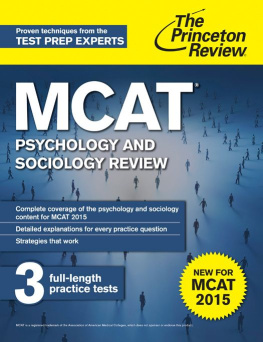I thank all my teachers: Kristin Krohn, Kerstin Vandervoort, my parents and grandparents, my brother, my friends, and my students.R.M.
To Sara, Kate, and EIi.A.W.
About the Authors
Allyson Weseley has taught AP Psychology and run a Behavioral Science Research Program at Roslyn High School in Roslyn Heights, NY for 17 years. Her students have enjoyed great success on the AP exam, with a 100% passing rate and well over 80% earning 5s. She earned an undergraduate degree in Psychology at Princeton University, a masters degree from the Harvard Graduate School of Education, and a doctorate from Columbia Universitys Teachers College. Dr. Weseley has served as a Reader and Table Leader for the AP Psychology exam, published a number of psychology-related activities, led several psychology teacher workshops, and served on the Board of Teachers of Psychology in the Secondary Schools.
Rob McEntarffer taught AP Psychology at Lincoln Southeast High School in Lincoln, NE for 13 years and Introductory Psychology at Nebraska Wesleyan University for 7 years. He earned a B.S. in teaching of psychology at the University of Nebraska, a masters degree in educational psychology, and is currently working on a Ph.D. in education. He has extensive experience in scoring the Advanced Placement Psychology free-response questions, having served as a Reader, Table Leader, and, as the high school Question Leader. He is past chair of the national organization Teachers of Psychology in Secondary Schools, worked with the committee on the National Standards for the Teaching of High School Psychology, and is involved in writing assessment materials for high school and college level introductory psychology textbooks. He works as an assessment specialist for his school district.
Copyright 2012, 2010, 2007, 2004, 2000 by Barrons Educational Series, Inc.
All rights reserved.
No part of this work may be reproduced in any form or by any means without the written permission of the copyright owner.
All inquiries should be addressed to:
Barrons Educational Series, Inc.
250 Wireless Boulevard
Hauppauge, New York 11788
www.barronseduc.com
ISBN: 978-0-7641-4701-2 (Book)
First e-Book publication: February, 2012.
eISBN: 978-1-4380-8344-5
Contents


T he purpose of this book is to provide you with the best-possible preparation for the AP Psychology exam. Becoming familiar with the structure of the test is an essential part of your preparation. Therefore, this book begins with an overview of the exam.
The book begins with a diagnostic test to help you gauge how best to prepare for the exam. You may wish to take this test after you have been exposed to all the information through your class but before you begin to study. The Multiple-Choice Error Analysis Sheet is intended to help you identify your areas of relative strength and weakness. For each of the 14 topic areas, compute the percentage of questions you answered correctly. In this test, the number of questions on a topic is indicative of the amount of attention it typically receives on the exam. Therefore, you should spend the most time studying the areas on which many questions were asked and you got a relatively low percentage of them correct.
In addition, we have included two full-length practice exams at the end of the book. Keep in mind that taking a practice exam under actual testing conditions (all at once and within the time limit) is always best. Every exam includes an explanation of the correct answers as well as an Error Analysis Sheet.
We devoted most of the book to a topical review of the main areas of psychology. The content is organized in such a way that it mirrors the format of the exam. These areas and their relative coverage on the AP exam are listed below:
| History and Approaches | 24 percent |
| Methods | 810 percent |
| Biological Bases of Behavior | 810 percent |
| Sensation and Perception | 68 percent |
| States of Consciousness | 24 percent |
| Learning | 79 percent |
| Cognition | 810 percent |
| Motivation and Emotion | 68 percent |
| Developmental Psychology | 79 percent |
| Personality | 57 percent |
| Testing and Individual Differences | 57 percent |
| Abnormal Psychology | 79 percent |
| Treatment of Psychological Disorders | 57 percent |
| Social Psychology | 810 percent |
The College Board recently revised the AP Psychology course to include specific course objectives (your AP Psychology instructor can provide more information about these objectives). We are not reproducing these course objectives in this review book for legal reasons, but the content of this book corresponds closely to these new course objectives.
Because this is a review book, our aim is to include only that information you need to know for the exam. Nonetheless, some of this information is particularly important and we convey that fact by highlighting such material as Tips . Important terms and people appear at the beginning of each chapter and are set in italics in the text. They can also be found in the index.
The College Board dramatically increased the number of psychologists named in their most recent revision of their course outline and all those people are described in this review book. However, we recommend that you do NOT spend a large part of your studying time memorizing all these names. The AP Psychology exam primarily focuses on psychological concepts and ideas, not people. We included a list of the most significant psychologists in the Fabulous 15 section and suggest that you focus your studying on those individuals.
Multiple-choice practice questions and an explanation of the correct answer are provided at the end of each review chapter. We recommend that you first review the material in the chapter and then answer all the review questions in order to test your comprehension.
To help prepare you for the exam, Chapter 15 presents a group of testing tips and Chapter 16 focuses on how to answer the free-response questions. We have included a discussion of how best to approach the essays and also provide a number of examples of the kinds of essay questions likely to appear on the exam. We also include model essay answers to give you an idea of what the readers of the exam are looking for.
Finally, the book includes an index that will be helpful to you anytime you come across a term or person you know is important, but do not remember. It will refer you to a page or pages that discuss that term or person.
This eBook contains hundreds of hyperlinks that will help you navigate through the content of the book, bring you to helpful resources, and allow you to click between all questions and answers. *Since this is an eBook, for all practice questions and model test questions, you will need to write your answers on separate sheets of paper. *Please note: This e-Book will appear differently depending on what e-reader device or software you are using to view it. Please adjust accordingly. |

